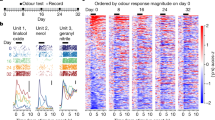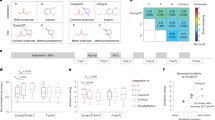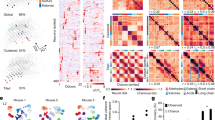Abstract
Learning to adapt to a complex and fluctuating environment requires the ability to adjust neural representations of sensory stimuli. Through pattern completion processes, cortical networks can reconstruct familiar patterns from degraded input patterns, whereas pattern separation processes allow discrimination of even highly overlapping inputs. Here we show that the balance between pattern separation and completion is experience dependent. Rats given extensive training with overlapping complex odorant mixtures showed improved behavioral discrimination ability and enhanced piriform cortical ensemble pattern separation. In contrast, behavioral training to disregard normally detectable differences between overlapping mixtures resulted in impaired piriform cortical ensemble pattern separation (enhanced pattern completion) and impaired discrimination. This bidirectional effect was not found in the olfactory bulb; it may be due to plasticity within olfactory cortex itself. Thus pattern recognition, and the balance between pattern separation and completion, is highly malleable on the basis of task demands and occurs in concert with changes in perceptual performance.
This is a preview of subscription content, access via your institution
Access options
Subscribe to this journal
Receive 12 print issues and online access
$209.00 per year
only $17.42 per issue
Buy this article
- Purchase on Springer Link
- Instant access to full article PDF
Prices may be subject to local taxes which are calculated during checkout





Similar content being viewed by others
References
Lee, I., Yoganarasimha, D., Rao, G. & Knierim, J.J. Comparison of population coherence of place cells in hippocampal subfields CA1 and CA3. Nature 430, 456–459 (2004).
Leutgeb, S., Leutgeb, J.K., Treves, A., Moser, M.B. & Moser, E.I. Distinct ensemble codes in hippocampal areas CA3 and CA1. Science 305, 1295–1298 (2004).
Barnes, D.C., Hofacer, R.D., Zaman, A.R., Rennaker, R.L. & Wilson, D.A. Olfactory perceptual stability and discrimination. Nat. Neurosci. 11, 1378–1380 (2008).
Haberly, L.B. Parallel-distributed processing in olfactory cortex: new insights from morphological and physiological analysis of neuronal circuitry. Chem. Senses 26, 551–576 (2001).
Wilson, D.A. & Stevenson, R.J. The fundamental role of memory in olfactory perception. Trends Neurosci. 26, 243–247 (2003).
McClelland, J.L. & Goddard, N.H. Considerations arising from a complementary learning systems perspective on hippocampus and neocortex. Hippocampus 6, 654–665 (1996).
Wesson, D.W., Donahou, T.N., Johnson, M.O. & Wachowiak, M. Sniffing behavior of mice during performance in odor-guided tasks. Chem. Senses 33, 581–596 (2008).
Fletcher, M.L. & Chen, W.R. Neural correlates of olfactory learning: Critical role of centrifugal neuromodulation. Learn. Mem. 17, 561–570 (2010).
Restrepo, D., Doucette, W., Whitesell, J.D., McTavish, T.S. & Salcedo, E. From the top down: flexible reading of a fragmented odor map. Trends Neurosci. 32, 525–531 (2009).
Kadohisa, M. & Wilson, D.A. Separate encoding of identity and similarity of complex familiar odors in piriform cortex. Proc. Natl. Acad. Sci. USA 103, 15206–15211 (2006).
Saar, D., Grossman, Y. & Barkai, E. Reduced synaptic facilitation between pyramidal neurons in the piriform cortex after odor learning. J. Neurosci. 19, 8616–8622 (1999).
Saar, D. & Barkai, E. Long-term modifications in intrinsic neuronal properties and rule learning in rats. Eur. J. Neurosci. 17, 2727–2734 (2003).
Martin, C., Beshel, J. & Kay, L.M. An olfacto-hippocampal network is dynamically involved in odor-discrimination learning. J. Neurophysiol. 98, 2196–2205 (2007).
Cohen-Matsliah, S.I., Rosenblum, K. & Barkai, E. Olfactory-learning abilities are correlated with the rate by which intrinsic neuronal excitability is modulated in the piriform cortex. Eur. J. Neurosci. 30, 1339–1348 (2009).
Brosh, I. & Barkai, E. Learning-induced enhancement of feedback inhibitory synaptic transmission. Learn. Mem. 16, 413–416 (2009).
Hasselmo, M.E., Anderson, B.P. & Bower, J.M. Cholinergic modulation of cortical associative memory function. J. Neurophysiol. 67, 1230–1246 (1992).
Nakazawa, K. et al. Requirement for hippocampal CA3 NMDA receptors in associative memory recall. Science 297, 211–218 (2002).
Freeman, W.J. & Schneider, W. Changes in spatial patterns of rabbit olfactory EEG with conditioning to odors. Psychophysiology 19, 44–56 (1982).
Fletcher, M.L. & Wilson, D.A. Olfactory bulb mitral-tufted cell plasticity: odorant-specific tuning reflects previous odorant exposure. J. Neurosci. 23, 6946–6955 (2003).
Doucette, W. & Restrepo, D. Profound context-dependent plasticity of mitral cell responses in olfactory bulb. PLoS Biol. 6, e258 (2008).
Doucette, W. et al. Associative cortex features in the first olfactory brain relay station. Neuron 69, 1176–1187 (2011).
Jones, S.V., Choi, D.C., Davis, M. & Ressler, K.J. Learning-dependent structural plasticity in the adult olfactory pathway. J. Neurosci. 28, 13106–13111 (2008).
Bakin, J.S., Lepan, B. & Weinberger, N.M. Sensitization induced receptive field plasticity in the auditory cortex is independent of CS-modality. Brain Res. 577, 226–235 (1992).
Kilgard, M.P. & Merzenich, M.M. Cortical map reorganization enabled by nucleus basalis activity. Science 279, 1714–1718 (1998).
Chen, C.F., Barnes, D.C. & Wilson, D.A. Generalized versus stimulus-specific learned fear differentially modifies stimulus encoding in primary sensory cortex of awake rats. J. Neurophysiol. doi:10.1152/jn.00721.2011 (14 September 2011).
Suzuki, N. & Bekkers, J.M. Inhibitory neurons in the anterior piriform cortex of the mouse: classification using molecular markers. J. Comp. Neurol. 518, 1670–1687 (2010).
Stokes, C.C. & Isaacson, J.S. From dendrite to soma: dynamic routing of inhibition by complementary interneuron microcircuits in olfactory cortex. Neuron 67, 452–465 (2010).
Suzuki, N. & Bekkers, J.M. Two layers of synaptic processing by principal neurons in piriform cortex. J. Neurosci. 31, 2156–2166 (2011).
Resnik, J., Sobel, N. & Paz, R. Auditory aversive learning increases discrimination thresholds. Nat. Neurosci. 14, 791–796 (2011).
Li, F., Wang, L.P., Shen, X. & Tsien, J.Z. Balanced dopamine is critical for pattern completion during associative memory recall. PLoS ONE 5, e15401 (2010).
Rinberg, D., Koulakov, A. & Gelperin, A. Sparse odor coding in awake behaving mice. J. Neurosci. 26, 8857–8865 (2006).
Barnes, D.C., Chapuis, J., Chaudhury, D. & Wilson, D.A. Odor fear conditioning modifies piriform cortex local field potentials both during conditioning and during post-conditioning sleep. PLoS ONE 6, e18130 (2011).
Beshel, J., Kopell, N. & Kay, L.M. Olfactory bulb gamma oscillations are enhanced with task demands. J. Neurosci. 27, 8358–8365 (2007).
Kay, L.M. & Beshel, J. A beta oscillation network in the rat olfactory system during a 2-alternative choice odor discrimination task. J. Neurophysiol. 104, 829–839 (2010).
Fell, J. & Axmacher, N. The role of phase synchronization in memory processes. Nat. Rev. Neurosci. 12, 105–118 (2011).
Kay, L.M. et al. Olfactory oscillations: the what, how and what for. Trends Neurosci. 32, 207–214 (2009).
Chapuis, J. et al. The way an odor is experienced during aversive conditioning determines the extent of the network recruited during retrieval: a multisite electrophysiological study in rats. J. Neurosci. 29, 10287–10298 (2009).
Cenier, T. et al. Respiration-gated formation of gamma and beta neural assemblies in the mammalian olfactory bulb. Eur. J. Neurosci. 29, 921–930 (2009).
Nusser, Z., Kay, L.M., Laurent, G., Homanics, G.E. & Mody, I. Disruption of GABA(A) receptors on GABAergic interneurons leads to increased oscillatory power in the olfactory bulb network. J. Neurophysiol. 86, 2823–2833 (2001).
Seckinger, R.A. et al. Olfactory identification and WAIS-R performance in deficit and nondeficit schizophrenia. Schizophr. Res. 69, 55–65 (2004).
Murphy, C. Loss of olfactory function in dementing disease. Physiol. Behav. 66, 177–182 (1999).
Tanila, H., Shapiro, M., Gallagher, M. & Eichenbaum, H. Brain aging: changes in the nature of information coding by the hippocampus. J. Neurosci. 17, 5155–5166 (1997).
Tanila, H., Sipila, P., Shapiro, M. & Eichenbaum, H. Brain aging: impaired coding of novel environmental cues. J. Neurosci. 17, 5167–5174 (1997).
Barnes, C.A., Suster, M.S., Shen, J. & McNaughton, B.L. Multistability of cognitive maps in the hippocampus of old rats. Nature 388, 272–275 (1997).
Wesson, D.W., Levy, E., Nixon, R.A. & Wilson, D.A. Olfactory dysfunction correlates with amyloid-beta burden in an Alzheimer's disease mouse model. J. Neurosci. 30, 505–514 (2010).
Li, W., Howard, J.D. & Gottfried, J.A. Disruption of odour quality coding in piriform cortex mediates olfactory deficits in Alzheimer's disease. Brain 133, 2714–2726 (2010).
Wilson, D.A. Single-unit activity in piriform cortex during slow-wave state is shaped by recent odor experience. J. Neurosci. 30, 1760–1765 (2010).
Fletcher, M.L., Smith, A.M., Best, A.R. & Wilson, D.A. High-frequency oscillations are not necessary for simple olfactory discriminations in young rats. J. Neurosci. 25, 792–798 (2005).
Smith, D.V. & Travers, J.B. A metric for the breadth of tuning of gustatory neurons. Chem. Senses 4, 215–229 (1979).
Preacher, K.J. Calculation for the test of the difference between two independent correlation coefficients. <http://quantpsy.org/> (2002).
Acknowledgements
This work was supported by US National Institutes of Health grants DC003906 and DC008982 to D.A.W. and a Fyssen Foundation post-doctoral grant to J.C.
Author information
Authors and Affiliations
Contributions
D.A.W. and J.C. designed the research. J.C. collected data. J.C. and D.A.W. analyzed and interpreted data. J.C. and D.A.W. wrote the paper.
Corresponding authors
Ethics declarations
Competing interests
The authors declare no competing financial interests.
Supplementary information
Supplementary Text and Figures
Supplementary Figures 1–3, Supplementary Table 1, Supplementary Results and Discussion (PDF 667 kb)
Rights and permissions
About this article
Cite this article
Chapuis, J., Wilson, D. Bidirectional plasticity of cortical pattern recognition and behavioral sensory acuity. Nat Neurosci 15, 155–161 (2012). https://doi.org/10.1038/nn.2966
Received:
Accepted:
Published:
Issue Date:
DOI: https://doi.org/10.1038/nn.2966
This article is cited by
-
Neuronal activity in sensory cortex predicts the specificity of learning in mice
Nature Communications (2022)
-
Basolateral amygdala to posterior piriform cortex connectivity ensures precision in learned odor threat
Scientific Reports (2021)
-
Structure and flexibility in cortical representations of odour space
Nature (2020)
-
Associative conditioning remaps odor representations and modifies inhibition in a higher olfactory brain area
Nature Neuroscience (2019)
-
A specific olfactory cortico-thalamic pathway contributing to sampling performance during odor reversal learning
Brain Structure and Function (2019)



